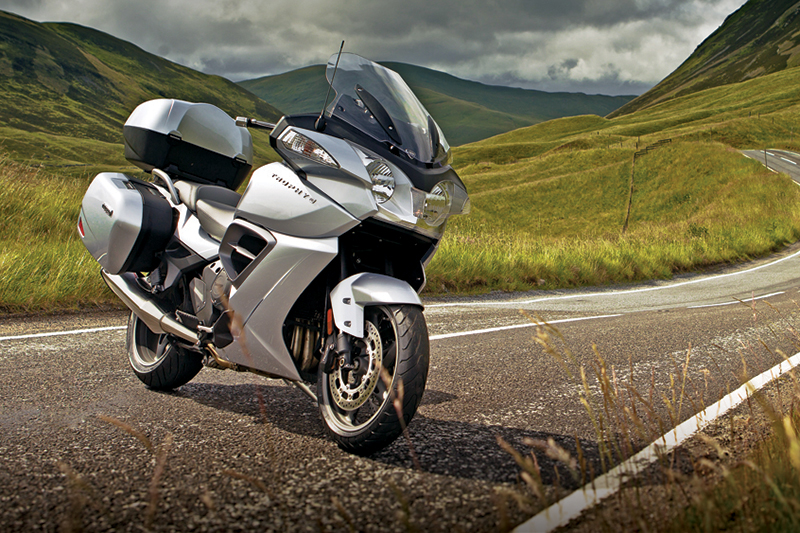2013 Triumph Trophy SE

First Ride Review
Is Triumph still salty about having its Coventry factory destroyed by the German Luftwaffe during World War II? The all-new Trophy, a sport tourer powered by the 1,215cc triple found in the Explorer, shares more than a passing resemblance with BMW’s perennial, Alps-bred R 1200 RT (Rider, September 2012). Beyond looks, the Trophy also takes after the RT with excellent wind protection, linked anti-lock brakes, shaft drive and spacious saddlebags. And the higher-spec Trophy SE—the only version that’s coming to the U.S. early next year—includes features BMW has offered for years but are new to Triumph, such as electronically adjustable suspension and an audio system. Is the Trophy a British knock-off of the German legend, or is it the motorcycling equivalent of V-Day?
To find out, Triumph held the world press launch in its own backyard. Scotland may be a reluctant member of the United Kingdom, but its moody, sheep-filled landscape is the perfect place to evaluate a sport tourer. Starting in St. Andrews, the birthplace of golf on the Fife coast, we completed a 250-mile inland loop, winding through quaint villages and the rotund mountains of Cairngorms National Park, on the left side of roads ranging from country lanes barely wider than our saddlebags to busy A-roads clogged with lorries. Our white-knuckle pace allowed us to evaluate handling, acceleration and braking in extremis, but it limited our ability to appreciate the Braveheart scenery (minus the blood-n-guts and blue face paint).
If you’ve read our tests of the Tiger Explorer (Rider, May and September 2012), then you know we’re impressed by Triumph’s romper-stomper 1,215cc in-line triple, good for 118.5 horsepower and 78.5 lb-ft of torque on Jett Tuning’s dyno, with a broad spread of torque. With a bore and stroke of 85mm x 71.4mm, a compression ratio of 11.0:1 and dual overhead cams actuating four valves per cylinder, the engine features a friction-reducing 6mm bore offset that boosts fuel economy and torque. The liquid-cooled, counterbalanced triple revs smoothly, transmitting minimal vibration to the rider. And power increases linearly, building speed quickly with an authoritative roar from the exhaust. Change the oil and filter every 10,000 miles, check/adjust the shim-under-bucket valves every 20,000 miles and you’ll be jolly good, mate.
Though the Trophy and Tiger Explorer were developed in tandem, they share little in common beyond the drivetrain. To cure the on/off throttle abruptness that was a common complaint on the Explorer, the Trophy’s throttle-by-wire was recalibrated for less sensitivity. The Trophy has a revised ECU to account for a different 3-into-1 muffler, a longer single-sided swingarm, more user-friendly cruise control, just two traction control settings (on/off) and a taller overdrive sixth gear. There was some notchiness in the two lowest gears, but otherwise the Trophy’s cassette gearbox shifted smoothly, with a moderate pull and good engagement from the hydraulic clutch. Also unique to the Trophy, the aluminum main frame uses the engine as a stressed member, weighs just 24.9 pounds and has a narrow center profile to make it easier to reach the ground.
Built by Austrian suspension maker WP, Triumph Electronic Suspension makes its debut on the Trophy SE, allowing pushbutton adjustments to front and rear damping (sport/normal/comfort) on the fly and to rear preload (rider only, rider + luggage, rider + passenger) when the bike is stopped. The 43mm male-slider fork offers 5.1 inches of travel, and the rear shock offers 4.7 inches of travel with a progressive linkage. Differences between the damping levels are pronounced and the suspension performed admirably on rollercoaster dips, off-camber corners, dodgy pavement and everything else the Scottish countryside threw at us. By design, the Trophy’s handling occupies that happy place where nimbleness and stability overlap. Its rear suspension geometry cancels out shaft jacking, its 51.5-percent front weight bias keeps the front tire planted and its standard Pirelli Angel ST tires (120/70-17 front, 190/55-17 rear) offer good turn-in, grip and feel.
Nissin makes the Trophy’s dual 4-piston/4-pad front calipers and 2-piston rear caliper. ABS is standard, and the brakes are linked rear to front. Light pressure on the rear pedal activates the rear caliper only; higher pressure activates the rear plus two pads of the left front caliper, with a proportional control valve sending more power to the front to prevent early engagement of the rear ABS. Ideal for sport touring, the Trophy’s binders are powerful and easy to modulate.
The Trophy’s V-shaped brow, dual headlights and integrated mirrors and turn signals mimic those found on the BMW R 1200 RT, making it blend-in rather than stand apart. But the RT arguably has the best wind protection in the class, so perhaps imitation makes sense. With deep cutouts for the rider’s knees and lipped edges on the fairing and mirror surrounds that widen the bubble around the cockpit, the cold, windy, wet weather in Scotland wasn’t bothersome. Electronically adjustable over a 6.5-inch range with a memory function, the windscreen is wide and well contoured, with a U-shaped cutout at the top to improve visibility. In the lowest position, wind crashed down on my shoulders but I experienced no helmet buffeting; in the highest position, I felt some negative pressure but very little wind. Twin-axial exhaust fans and sealed fairing panels are designed to keep engine heat away from the rider, to good effect. The wide, flat seat is height adjustable (30.1/31.1 inches) and provided good support during our all-day ride. The pegs seemed high for my 34-inch inseam, but otherwise the riding position was spot-on.
The Trophy’s 31-liter-each saddlebags employ the unique Triumph Dynamic Luggage System, allowing side-to-side movement through a 5-degree arc and with arms in the tail section linking them together. TDLS is said to suppress unwanted oscillations and improve stability at speed, but since the bags carried only rain gear, the added benefit wasn’t noticeable (but the bags wiggling around on the bikes in front of me was). The saddlebags’ locking mechanism was quirky and the lids were difficult to close, but each one holds an XL full-face helmet. There’s a small, waterproof storage compartment in the upper fairing that locks automatically when the ignition is turned off, and it includes a 12V socket, a USB port and a clip for holding a credit card. Claimed load capacity is a respectable 527 pounds.
Instrumentation is first-rate, offering a full complement of information and customization options, controlled via two buttons on the left handlebar like those on the Explorer. The menu controls what information is displayed on the dot-matrix screen, as well as traction control, suspension adjustment, rider preferences, headlight angle and much more. A larger switch pod farther inboard controls windscreen height, heated grips (if installed) and the audio system. The audio controls are difficult to reach without taking your hand off the grip, but the system is easy to use and includes AM/FM, iPod compatibility, satellite radio (3-month subscription included) and Bluetooth integration. Ported speaker enclosures provide high-quality sound and the volume’s speed sensitivity is adjustable, but since I spent most of the ride hauling haggis while wearing a full-face helmet and earplugs, I couldn’t hear the music very clearly. Other useful features include a standard tire-pressure monitoring system, three 12V sockets and 950 watts of charging output. Accessories include heated grips and rider/passenger seat, a tankbag, pannier liners, a touring screen, a taller seat, a GPS mounting bracket and a top box with internal 12V socket.
The Trophy seems to be a bloody good motorbike. It has the performance to excite, the amenities to satisfy, and the technology to dazzle. The more I rode it, the more I wanted to ride it, and the farther I wanted to go. And Bob’s your uncle!
